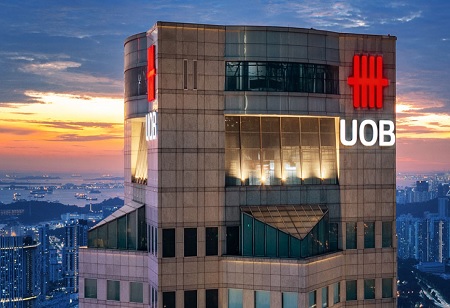
UOB Targets Dominance in $2 Trillion Southeast Asia Trade Finance Market

 United Overseas Bank (UOB), Singapore’s third-largest bank by assets, is setting its sights on becoming a leader in trade financing across Southeast Asia. Leveraging the region's growing significance amid the escalating US-China trade tensions, the bank aims to increase its share of the US$2 trillion trade flows. Frederick Chin, head of group wholesale banking and markets, stated that UOB is focusing on expanding its presence among both small and medium enterprises (SMEs) and large corporations.
United Overseas Bank (UOB), Singapore’s third-largest bank by assets, is setting its sights on becoming a leader in trade financing across Southeast Asia. Leveraging the region's growing significance amid the escalating US-China trade tensions, the bank aims to increase its share of the US$2 trillion trade flows. Frederick Chin, head of group wholesale banking and markets, stated that UOB is focusing on expanding its presence among both small and medium enterprises (SMEs) and large corporations.
“The bright spot will be in ASEAN for the next few years”, he said in an interview in Ho Chi Minh City last week, referring to the grouping of Southeast Asian nations. “We are already the number one trade bank in Asean, and I want to invest [our resources] to dominate this region”. As global manufacturers implement 'China plus one' strategies to cushion the impact of the US-China tensions, Southeast Asia has become a major beneficiary of the disruptions in supply chains. Consequently, last year, the leading economies in the region attracted more foreign direct investment than China for the first time in ten years.
UOB’s global wholesale banking division provides a wide array of products, including loans, trade services, cash management, and advisory services. According to the bank’s annual report to shareholders, this segment achieved a record income of S$7.1 billion (US$5.5 billion) in 2023. Despite its significant presence in the region, UOB holds only 1 percent of the market, with approximately US$22 billion in trade assets for 2023, as noted by Chin. This presents ample opportunity for his team to capture a larger share of the cross-border trade banking market.
“Nobody dominates this space,” Chin added. “That is why I want to invest heavily. Five percent by 2026 is my initial target”. UOB, which started building capabilities in the region through cash management, financial supply chain management and payments capabilities a decade ago, is now reaping the benefits of its foresight. The rapid digital migration and manufacturing relocation, induced by the Covid-19 pandemic, have provided additional tailwinds for lenders.
“As the pressure mounted, they started playing out a lot more in our favour”, Chin said. “We hope that can be sustained, and I believe it will be”. Big regional corporate clients will remain the bank’s priority, while for multinational companies, UOB is looking to position itself as a regional service bank complementing global banking peers. SME suppliers will also be a focus to build a closed-loop business ecosystem, Chin added.
UOB is also eager to capitalize on sectoral trends in Southeast Asia. Key areas of focus include Malaysia’s semiconductor industry, Indonesia’s potential in mining and renewables, Thailand’s investments in higher-value sectors and automotive, and Vietnam’s strength in electronics and textiles, he added. “Our strategy for future growth is all about connectivity”, Chin said. “We aim to do well to capture foreign direct investment. When companies build factories, we finance them. And from there, we can capture the goods and subsequent trade flows”.

